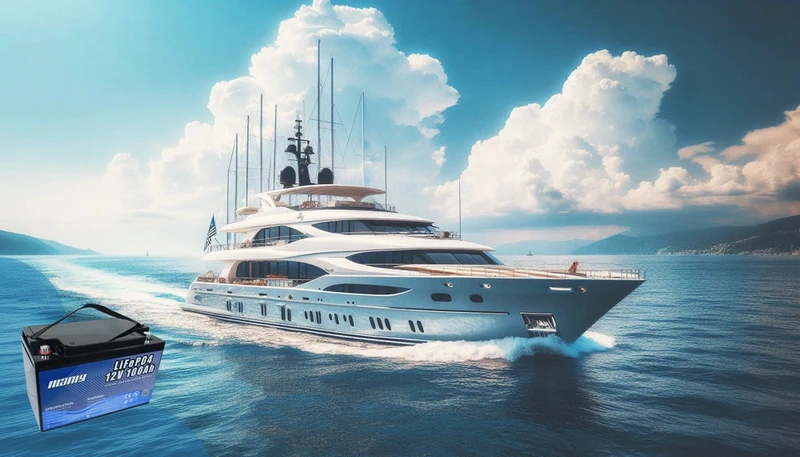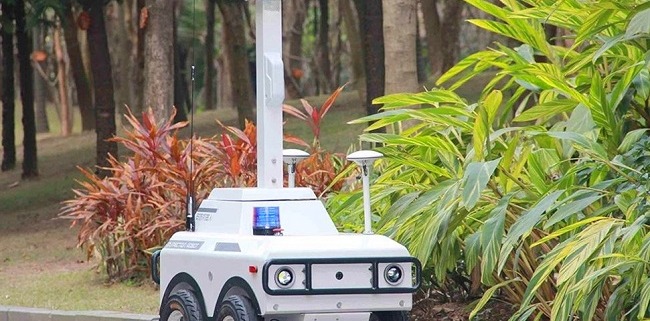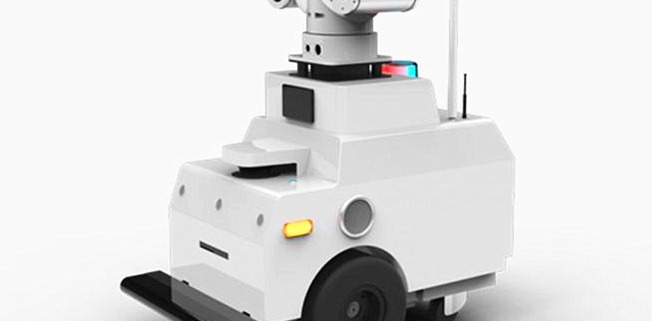Charge a Marine Battery: Step-by-Step Guide
Table of Contents
- Charge a Marine Battery: Step-by-Step Guide
- Understanding Marine Batteries
- Preparing to Charge Your Marine Battery
- Step-by-Step Guide: How to charge a marine battery
- Best Practices for Marine Battery Maintenance
- Conclusion
- FAQ
- Hot Resarch
- 2024 UK Mother’s Day: Lifepo4 Battery, a Meaningful Gift
- In the future, security robots will show their talents
- The advantages and development trend of security robots
Marine batteries are the lifeblood of any boat—they power your engine, lights, gauges, and all the essential onboard electronics. Without a healthy battery, your boat is a pretty shell on the water. In this article, we dive into the burning question: how do I charge a marine battery? We’ll explore everything from the ins and outs of battery types to a step-by-step guide on charging. Plus, we’ll compare the advantages of a marine li ion battery with those of traditional marine deep cycle batteries. Let’s get started on this exciting journey to keep your boat powered and your adventures safe!
Understanding Marine Batteries
1. Types of Marine Batteries
Not all marine batteries are created equal. When it comes to powering your boat, you typically have three choices:
- Starting Batteries: These provide that quick, powerful burst of energy to get your engine running, but they’re not built for long-term power.
- Deep Cycle Batteries: Designed for sustained power delivery, these batteries keep your lights, electronics, and other accessories humming for hours.
- Dual-Purpose Batteries: These offer a blend of starting and deep cycle capabilities, which can be handy on smaller vessels with limited space.
Most boaters prefer marine deep-cycle batteries for extended use and reliability. These batteries handle deep discharges better, ensuring their boats stay powered even during extended trips.
2. Battery Chemistry and Technology
Battery chemistry plays a pivotal role in performance and longevity. Traditional chemistries—like lead-acid, AGM, and gel—have long been the go-to options. However, a modern contender is changing the game: the marine li ion battery.
Why choose a marine li ion battery? Because it’s lightweight, lasts significantly longer, and requires minimal maintenance compared to conventional batteries. Think of it as upgrading from an old clunker to an award-winning sports car in the world of batteries. This cutting-edge technology improves performance and enhances safety and efficiency, making it a popular choice among serious boaters.
Learn more about lithium-ion battery technology on Wikipedia.
Preparing to Charge Your Marine Battery
Before you begin the charging process, a little preparation goes a long way toward ensuring safety and efficiency.
1. Assessing Your Battery’s Condition and Type
First, give your battery a thorough once-over. Check its age, inspect for any signs of corrosion, and verify the battery type. Understanding whether you’re dealing with a marine li ion battery or deep cycle batteries is crucial—it influences which charger to use and how you’ll maintain it. A well-maintained battery lasts longer and performs better when you charge a marine battery.
2. Choosing the Right Charger
Next up is selecting the correct charger. You generally have two main options:
- Onboard Chargers: Permanently installed on your boat, these chargers make it super convenient to power up as long as you have access to a standard outlet.
- Portable Chargers: These allow you to charge your battery wherever you are, which is ideal for smaller boats or when space is at a premium.
Make sure the charger you choose matches your battery’s chemistry and voltage. This step is especially important for those opting for a marine li ion battery or deep cycle batteries—using the wrong charger can lead to underperformance or even damage.
3. Safety Precautions Before Charging
Safety should always be your top priority. Here are some key precautions:
- Work in a Safe Environment: Charge your battery in a well-ventilated area and ensure the temperature is within the manufacturer’s recommended range.
- Clean Battery Terminals: Dirty or corroded terminals can interfere with the charging process, so give them a good clean before you connect anything.
- Gear Up: Wear protective gear such as gloves and eye protection to prevent mishaps.
- Follow Manufacturer Guidelines: Always adhere to the specific recommendations provided by your battery and charger manufacturers.
By taking these simple steps, you will ensure your safety and optimize the performance and lifespan of your battery.
Step-by-Step Guide: How to charge a marine battery
Let’s get into the nitty-gritty of charging your boat’s power source. Follow these steps, and you’ll power up like a pro in no time!
1. Cleaning and Inspecting Battery Terminals
Before you plug anything in, clean your battery terminals. Dirty or corroded terminals can prevent your charger from doing its job, and no one wants a slow charge on a hot day!
- Tip: Mix some baking soda with water, scrub gently with a soft brush, and wipe dry.
- Why It Matters: Clean connections ensure that every bit of energy flows efficiently when you charge a marine battery.
2. Connecting the Charger
Now, let’s hook everything up:
- Positive (Red) Cable: Firmly attach this to the positive terminal.
- Negative (Black) Cable: Connect it securely to the negative terminal.
Double-check your connections, whether using a smart charger that adjusts the current automatically or a trusty manual charger. This step is vital, especially when working with a marine li ion battery or marine deep cycle batteries. Once the cables are locked in, plug in your charger and power it up. Easy as pie, right?
3. Monitoring the Charging Process
Keep an eye on your battery as it charges—this is where modern tech shines:
- LED Indicators: These give you a quick look at the charge level.
- Smart Apps & Timers: Many chargers have apps or built-in timers to let you know when you’re full.
By actively monitoring, you prevent overcharging and ensure your battery gets the right amount of juice.
4. Disconnecting the Charger Safely
When your battery is fully charged, it’s time to disconnect—but do it safely:
- Unplug the Charger: Always start by unplugging the charger from the wall.
- Remove the Negative Cable: Disconnect the black cable first.
- Disconnect the Positive Cable: Finally, remove the red cable.
Following this order helps prevent accidental short-circuits and keeps your battery in shape.
Best Practices for Marine Battery Maintenance
Regular maintenance keeps your battery performing like a champ. Here’s how to keep those power levels up!
1. Maintenance Tips for Prolonging Battery Life
- Routine Inspections: Check for any signs of corrosion or wear on the terminals.
- Clean Regularly: A little cleaning goes a long way in ensuring your connections are solid.
- Water Topping: Top up with distilled water when needed for lead-acid batteries.
By following these habits, you’ll always be ready to charge a marine battery and hit the water confidently.
2. Optimizing Charging Cycles
Different batteries have different needs:
- For a marine li ion battery: Enjoy the benefits of minimal maintenance and the ability to handle deeper discharges.
- For marine deep cycle batteries: Stick to regular, shallow discharges to keep them healthy over the long haul.
Tailoring your charging cycle to the specific battery type maximizes performance and extends lifespan.
3. Troubleshooting Common Issues
Even the best-maintained batteries can run into issues. Watch out for:
- Overcharging: This can overheat your battery and cause damage.
- Undercharging: Leaves your battery underpowered.
- Terminal Corrosion: Hinders efficient energy transfer.
If you notice any problems, check your charger settings and ensure you use the right equipment for your battery type.
Conclusion
1. Recap of Key Points
We’ve broken down how to charge a marine battery step by step—from cleaning and connecting to monitoring and safe disconnection. Each stage is crucial for keeping your boat’s power system in peak condition.
2. Final Tips for Maintaining Both Marine li ion battery and marine deep cycle batteries
Whether you opt for the cutting-edge marine li ion battery or the reliable marine deep cycle batteries, proper care and regular maintenance are your best friends. Tailor your charging habits to your battery’s specific needs, and you’ll enjoy award-winning performance on every trip.
3. Encouragement to Follow Best Practices for Reliability on the Water
Stick to these best practices, and you’ll be cruising with confidence. Keeping your battery in prime condition means fewer hassles and more time enjoying your time on the water. Let’s keep those adventures rolling, shall we?
For more detailed battery care tips and industry insights, check out reputable sources like the U.S. Department of Energy or Wikipedia’s battery technology page. Happy boating!
FAQ
1. Can you charge a marine battery with a regular charger?
While you technically can, it’s not recommended. Marine batteries require a charger that matches their specific chemistry and voltage. A regular charger may not provide the proper charging profile, leading to undercharging, overcharging, or even damage over time.
2. What is the best way to charge a boat battery?
The best way is to use a charger specifically designed for your battery type. Follow a step-by-step process: clean and inspect the terminals, connect the positive and negative cables correctly, monitor the charging process using bright indicators, and disconnect safely when fully charged. This ensures efficiency and longevity.
3.What kind of charger do I need for a marine battery?
You need a charger that is tailored to your battery’s chemistry—whether it’s a marine li ion battery or marine deep cycle batteries. Look for chargers with the correct voltage, charging algorithm, and safety features like automatic shut-off and intelligent monitoring for optimal performance.
Hot Resarch
Marine Battery Battery Manufacturer Lithium Battery
Hello
With the progress of the times, intelligent products gradually appear in the public eye, and the robot industry has also begun to develop by leaps and bounds.
At present, under the upsurge of artificial intelligence, the traditional security inspection industry is facing huge challenges. Therefore, the security inspection industry has to undergo technology and model transformation, and security inspection robots also contain new market opportunities.
The security inspection robot is an unmanned inspection system based on 5G communication. It is a device that integrates technologies such as the Internet of Things, artificial intelligence, cloud computing, and sensors. As a subdivision of the special robot industry, the security inspection robot is mainly based on the actual needs of life, and is used to solve hidden safety hazards, patrol monitoring and disaster warning, so as to reduce the occurrence of safety accidents and reduce the loss of life and property.
Due to the advantages of security inspection robots, they are gradually applied to various special places to help people complete monitoring and security work.
Substation security inspection robot: It mainly adopts the respirator color recognition system, instrument detection system, infrared measurement system, etc. The integration of various technologies enables the security inspection robot to autonomously inspect indoor and outdoor high-voltage equipment, and can give early warnings and find inspections. Equipment failure and other problems, provide operators with detection data, maintain the normal operation of equipment, and provide safety guarantees for relevant staff.
Disaster prevention and security inspection robot: It is mainly used to detect agricultural and forestry geological conditions. Through control devices, identification systems, transmission methods, etc., it can conduct security detection on various terrains such as mountains and steep slopes, realize data collection, and finally form a Complete monitoring system.
Daily security inspection robot: It is mainly used at the gate of the community or at various entrances and exits, and can also be used as a security guard. It integrates high-definition cameras, infrared thermal imaging, environmental sensors, and warning light devices. It can perform tasks autonomously, 24-hour all-round audio and video monitoring, and automatic alarms for abnormal situations. Therefore, it saves a certain amount of labor costs.
In addition to the common technologies of mobile robots, security inspection robots also need navigation and positioning, computer vision, movement and motion control, target detection and recognition, sensors, human-computer interaction and other related technologies under the factors of security application goals and environment. support. Among them, navigation and positioning technology is the most basic technical requirement of security inspection robots. Therefore, researchers are required to provide the best navigation for security inspection robots according to different application scenarios, combined with environmental characteristics, navigation accuracy, implementation cost and reliability. positioning scheme.
The security inspection robot market is a market with great potential, and it is also an industry with a lot of accumulation. Its development direction is mainly focused on image and video accurate recognition, big data mining, intelligent early warning and other aspects. How to seize the opportunity and how to develop and evolve have become key issues. Overall, the future development prospects of security inspection robots are worth looking forward to.
Robot technology has always been a research field that humans attach great importance to. As the technology with the most research and development value in the future, it will be widely used in various high-tech industries. In recent years, robots have become more and more intelligent, and the reason is due to the development of a series of emerging technologies, mainly including cloud computing, artificial intelligence, big data, computer vision, etc. In particular, the rapid development of artificial intelligence has enabled robots to have higher intelligence and can replace humans to undertake more and more important tasks
According to statistics, in the security group, security personnel over 40 years old are as high as 55%. As a result, the security industry is in an unstable state. At the same time, the existing products in the security industry have certain problems. One is that there are many types, but single functions and lack of flexibility; secondly, the existing security products cannot intelligently process monitoring information and require manual processing. In addition, a large number of security personnel are required, and the timeliness of information processing may be affected by other factors. With the rapid development of information technology and the rapid growth of the real estate industry, the concept of smart city has emerged spontaneously, and security robots have quietly emerged as a complex of comprehensive artificial intelligence, automatic control and other technologies.
The security robot will be based on the mobile control platform, on which the navigation system, inspection system, vision processing technology, feature recognition, positioning technology and other technologies will be built. Compared with the previous security system, the security robot has the following advantages:
24/7 autonomous patrol. In the automatic patrol mode, the robot does not need too much human intervention. The robot will control the movement of the mobile platform according to its own navigation system and positioning system. At the same time, multiple robots can be used in the patrol area to form a patrol network without dead ends, so that even if one robot is automatically charging, other robots can automatically patrol, which makes the security work more stringent.
Intelligent analysis and alarm. Security robots can be equipped with various sensors: cameras, temperature sensors, gas sensors, temperature sensors, and more. Using sensor information, combined with computer vision, speech recognition, sensors and other technologies to monitor the surrounding environment in real time. When the robot finds a suspected abnormality through pedestrian identification, smoke detection, temperature detection, etc., it can actively turn on its own alarm device, and notify the corresponding security personnel through the Internet and other means.
Compared with humans, robots can continue security patrol work in relatively harsh environments, such as strong winds, heavy rains, cold, and high temperatures.






